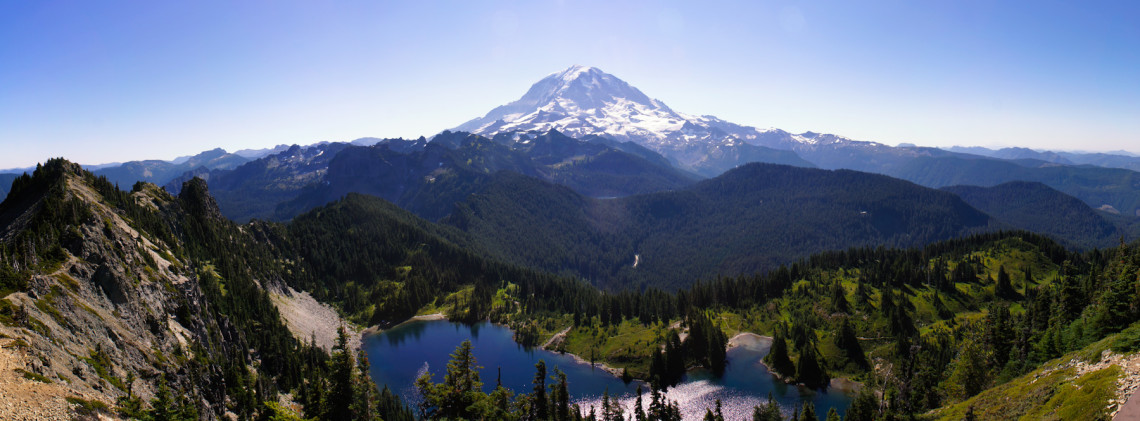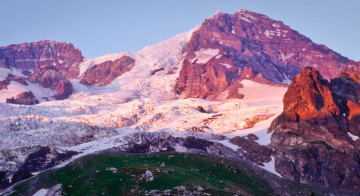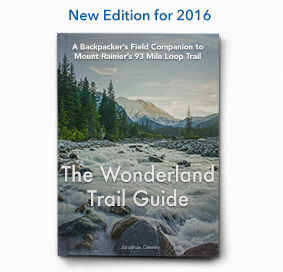
The Wonderland Trail has grown in popularity over the last several years, leaving many hikers disappointed to discover they can’t obtain the wilderness camping permits required to complete the trail.
If you find yourself in this position, this fortunately doesn’t mean you need to cancel your vacation plans.
There are two things in your favor: First, the Wonderland Trail has many access points around the park, and second, the park service reserves some permits for walk-ins on a first-come-first-served basis, issued on the morning of your hike.
In regards to the walk-in permits, it’s unlikely you can obtain one for more than one or two consecutive nights, but it doesn’t hurt to check. Just go to one of the many ranger stations in the park in the morning and see if they have anything open.
There are several large campgrounds in the park where you’ll usually be able to stay, so with this in mind, you can also explore the Wonderland Trail by day-hiking, which doesn’t require a permit.
With the reduced pack-weight of only carrying a day-pack, you can also cover greater distances than backpackers before running out of steam. Just be sure to bring the ten essentials and be prepared for bad weather.
If you were to bring two cars, this could be made more convenient as you’d never need to backtrack. Even better, if you hike opposing directions with another party, you can swap keys when you meet, cutting down the driving necessary. If you do this, be careful to not bite-off more than you can comfortably hike in a day, and have a plan for if you find yourself on the trail after dark. Also, it is not advisable to hike solo in case an emergency arises, so this is best done with a minimum of two pairs of people.
Here is a proposed itinerary for such a trip, assuming you’re in very good physical condition and have two cars. Some of the longer days may be too difficult for people who aren’t in good shape.
Be honest with yourself about your fitness levels before attempting any difficult sections that require you to hike between trailheads (as opposed to turning around when you get tired). Always be prepared to spend the night in the woods in case an emergency arises.
Section 1 The NE Corner
Park a car at Box Canyon and then drive to Sunrise. Spend a day hiking westward toward Granite Creek, and then return to Sunrise. There are a few side-trips in this section, the most notable being the Mount Fremont fire lookout and Burroughs Mountain, and you could easily spend three days seeing all the sites before moving onward.
During this time, stay at the White River car campground.
Section 2 The East Side
When you’re ready to move on, go early in the morning to the ranger station and try to obtain a walk-in permit for either Summerland or Indian Bar.
If you get a permit, then do a one-night trip from the Fryingpan Creek trailhead to Box Canyon, staying at Summerland or Indian Bar.
Fryingpan Creek to Box Canyon is a challenging section of trail and is best not attempted in a single day. Furthermore, there will be snow at Panhandle Gap until late in the season, making this a challenge to both speed and navigation.
You can hike up Fryingpan Creek toward Summerland and then turn back midday (go all the way Panhandle Gap if you have the energy). Spend another night at White River. The second day, you could day-hike from Box Canyon up Cowlitz Divide toward Indian Bar, and double-back after you’ve had your fill. Spend the night either at White River or Cougar Rock.
Experienced endurance hikers sometimes hike from Fryingpan Creek to Box Canyon (over 16 miles) over Panhandle Gap in a single day. This is quite challenging, and you’ll be racing the sun, so be prepared to spend a night in the wilderness if you can’t make good enough time. Before late summer, there will be snow on the ground at higher elevations and this will make progress slower, difficult, and more hazardous. Panhandle Gap is the highest point on the Wonderland Trail and can be a dangerous place before the snows melt, so do your research and discuss your plans with a ranger before leaving. This would be best attempted at the end of summer or in early autumn.
Section 3 The South Side
After retrieving your second car from the Fryingpan Creek trailhead, leave one vehicle at Box Canyon and then drive to Reflection Lakes. Hike east from Reflection Lakes for an easy day down through Stevens Canyon to Box Canyon. Spend the night at the Cougar Rock car campground.
Leave a vehicle at Longmire and drive up to Reflection Lakes. Hit the Pinnacle Peak trail (2.6 miles round-trip) if you have the energy, and then hike the WT back down to Longmire (5.5 miles). If you don’t feel up for a climb to Pinnacle Peak, an easier alternate side-trip is to hike the 3 mile loop from Reflection Lakes over the High Lake Trail. Spend the night at the Cougar Rock car campground.
Section 4 The West side
The west-side of the mountain is the most remote, and this will be the most difficult to visit if you can’t get a walk-in permit for two nights. See if you can get a permit for Golden Lakes for the first night, and South Puyallup or Klapatche Park for the second. If you’re successful, leave a car at Longmire and drive to Mowich Lake (allow about two hours for this) and hit the trail southbound.
When you reach Longmire on the third day, you can either spend the night at Cougar Rock, or drive up to the Mowich Lake car campground, or the nearby Evans Creek campground.
If you can only get a walk-in permit for only a single night at South Puyallup or Devil’s Dream, do an overnight trip from Longmire to this destination and then hike back the next day. Spend the night at Cougar Rock.
If you can’t get any walk-in permits, day-hike from Longmire to Indian Henry’s Hunting Ground (about 13.6 miles round-trip). This will be a challenging day, but it will all be downhill coming back. Spend the night at Cougar Rock.
The next day, drive up the Westside road to the point where it’s closed. From here, hike up the road several miles until you reach the South Puyallup trail near the Marine Memorial Airplane Crash Monument. Follow the South Puyallup trail 2.1 miles and turn right at the junction with the Wonderland Trail. Climb another ~1.8 miles to Emerald Ridge, the destination for the day. Turn around here and follow the same route back to your car. Note that the Tahoma Creek trail is closed, so you won’t be able to make a loop-hike over Emerald Ridge (this would make an unfortunate discovery after descending the south-side of Emerald Ridge). Spend the night at Cougar Rock, or drive around to the Mowich Lake area.
While it’s not one of the more notable sections of trail, you could spend a day hiking southward from Mowich Lake into the Mowich Valley and then back again. If you weren’t able to see Golden Lakes, you could also try to get a walk-in permit for one night here.
Section 5 The NW Corner
Drive to Mowich Lake and obtain a walk-in permit for two nights at the Ipsut Creek campground. Ipsut Creek used to be a car campground before the road washed-out, and has plenty of space, so this shouldn’t be a problem. Phone the Wilderness Information Center before planning on this, just to be certain.
On the first day, hike over Spray Park to Ipsut Creek, about 11 miles.
The next day explore Carbon Glacier, day-hiking eastward toward Mystic Lake, as far as you feel like. Return to Ipsut Creek for the night. Also consider making the short trip to Chenuis Falls from Ipsut Creek in the morning or evening.
On the third day, return to Mowich Lake via Ipsut Pass along the Wonderland Trail. If the weather is clear, it’s worth making a trip up Tolmie Peak once you climb to the top of the pass.
If you’ve followed this itinerary, you’ve now hiked a good portion of the Wonderland Trail. With all the car camping, you’ve probably enjoyed an air mattress and a light pack for much of it, in addition to way better food than most backpackers.

